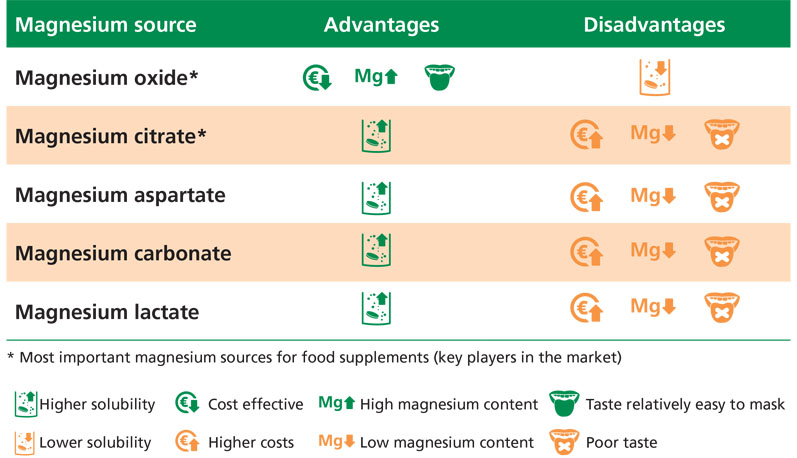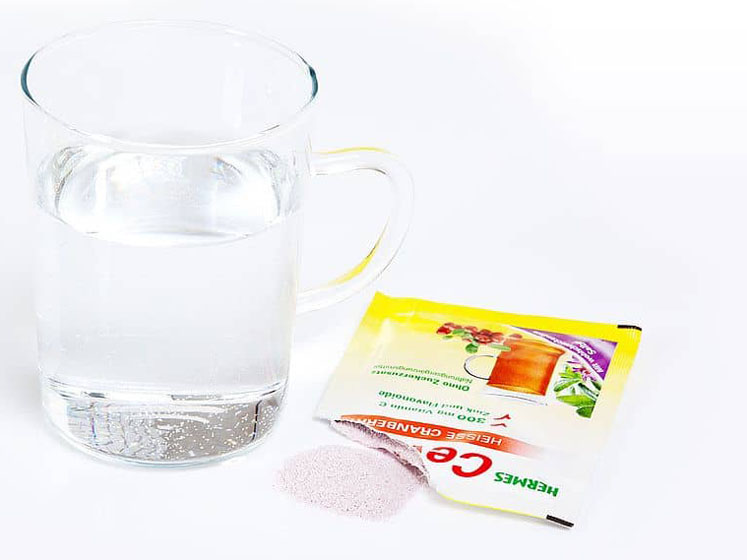Despite the human body only containing 25 g of magnesium, this element is essential for a wide range of vital cellular functions, from normal energy metabolism and electrolyte balance to central nervous system function, protein synthesis, blood pressure regulation and normal muscle function.
Magnesium deficiency is a growing health concern, especially in countries where people consume high levels of convenience foods with only low traces of magnesium.
Indeed, the average diet in the US contains only approximately 50% of the recommended dietary allowance (RDA) for magnesium; as such about half of the total population is estimated to have a magnesium-deficient diet.
Magnesium deficiency can cause a range of problems such as fatigue, nausea and muscle cramps, as well as indirect effects including a reduced ability to metabolise vitamin D. In more extreme cases, magnesium deficiency is associated with health conditions such as heart disease and diabetes owing to the presence of elevated levels of inflammation markers in the body.
Several population groups are more at risk of magnesium deficiency, such as people with type II diabetes, gastrointestinal diseases including Crohn’s disease or those who take proton pump inhibitor medicines (such as Omeprazole and Pantoprazole) to treat acid reflux. Adults older than 65 can also be susceptible to magnesium deficiency because of lower dietary intakes and the increased likelihood of chronic diseases.
With magnesium deficiencies rising, there is a growing need for magnesium supplementation. This is especially important for at-risk patient groups as well as consumers such as women during pregnancy, or who are breastfeeding, and people who do a lot of sports and suffer from muscle cramps.

Beyond these risk groups, magnesium supplementation is also beneficial for the wider population as it is essential for processing other supplements such as vitamin D and can help to relieve headache and back pain owing to its effects on muscle relaxation.
Making supplements easy to use
Our modern lifestyles demand ever-greater levels of convenience, not least when it comes to diet and supplementation habits. Factors such as an unpleasant taste or being hard to swallow can deter consumers and patients from consistent intake.
It’s therefore important to consider how manufacturers can best facilitate the way that consumers and patients take magnesium supplements.
A survey conducted by HERMES PHARMA found that more than 50% of people in the US and Germany have difficulties swallowing tablets or capsules. It might be easy to assume that elderly people have the greatest difficulty with swallowing, but data shows that 70% of younger people aged 16–34 also struggle with larger tablet and capsule forms.
Other data show that individuals can have different preferences for the various types of supplement dosage form. For example, many people who take supplements during or after sports prefer effervescent products to add to drink bottles, liquids or orally disintegrating granules.
These data indicate that a variety of high-quality and user-friendly dosage forms are required to meet the needs of modern consumers and patients. For this, convenience is key: it is increasingly important for supplements to be easy to prepare, taste good and be rewarding when integrated into daily routines.
To ensure that supplementation is effective, manufacturers must consider the technical aspects of how the supplements are manufactured to aid nutrient absorption.
For example, the body is more effective at absorbing magnesium when it is supplied as a steady stream compared with a spike when a high concentration of magnesium is ingested.
There is a range of different delivery form options to achieve the correct dosage requirement. One approach is for consumers and patients to take several low-dose tablets each day.
However, this is inconvenient and may result in people missing tablets. A more optimal way is to take a single daily dose of a user-friendly form of supplementation that provides sustained magnesium delivery.
As alternatives to simple tablet or capsule forms, HERMES PHARMA has developed sustained-delivery dosage forms that assist in user-friendly magnesium supplementation.
These include orally disintegrating granules (ODGs) that can be poured into the mouth from a stickpack. Other dosage forms with quicker release include effervescent tablets that are dissolvable in water and powders (that are also dissolved in water) for an instant drink.
Understanding the formulation issues
The development of user-friendly dosage forms can be challenging. It requires significant formulation and development expertise, as well as an understanding of consumer and patient needs.

There are numerous technical and practical considerations when developing your user-friendly formulation. At HERMES PHARMA, we have adopted a number of different production method options that do exactly this.
Application of expert formulation knowledge
There are a large number of magnesium salts available to choose for different applications (Table I). These salts have differences in cost, taste, solubility and particle size that all impact the way they are used in different dosage forms.
Magnesium oxide, for example, is a small molecule that is more commonly used than other salts, such as magnesium citrate. Magnesium oxide is cost-effective and requires a lower amount of API than magnesium citrate because it has the highest magnesium concentration of all salts.
Magnesium oxide is used in ODGs, allowing for large dosages of magnesium content (150–500 mg) that can be mixed with other nutrients, such as B-vitamins.
Organic salts of magnesium require higher amounts to reach the dosage requirement, meaning that when used in tablets they are normally too big to swallow comfortably.
However, organic salts can be used in ODGs and in combination with magnesium oxide; the advantage being that organic salts are easier to absorb into the bloodstream than magnesium oxide.

Table I: Comparison of different magnesium sources
Coating technologies
Applying a coating to magnesium salts is another production method that can influence the desired outcome of dosage forms. Different coating agents can be used to affect the rate of dissolution, meaning that there can be extended or sustained release of the nutrient to aid absorption.
Hot melt coating (HMC) is a technology that enables extended-release formulations. HMC covers particles of the magnesium with a layer of lipid excipient.
The addition of selected emulsifiers to the excipient mix can be used to adjust the rate of dissolution to meet the product’s requirements. Such coated particles can be used to manufacture ODGs that can be poured directly into the mouth. This dosage form is ideal for supplying high doses (up to 500 mg) of coated magnesium and additional nutrients (B-vitamins, for example).
Granulation technologies
For a variety of reasons, the granulation of particles is needed to optimise the quality of the product, especially for effervescent dosage forms that are designed to dissolve rapidly and completely in water, and to keep the products stable against moisture during production, shipping and storage.
Granulation technologies also enable the manufacturing of different effervescent forms. For example, technologies that cause strong bonds between primary powder particles allow the powder to be compressed into effervescent tablets or manufactured as instant drinks.

Granulation also aims to improve the overall quality of the supplement. Certain technologies can reduce the amount of dust within the powder, improving the overall flowability and ensuring that the API is homogenously distributed in the blend, whereas other technologies alter the morphology of powder particles to an optimal particle size distribution. This reduces the number of particles with unwanted/awkward shapes (such as needle-shaped particles), which are difficult to process.
Overall, the physical process of granulation reduces the accessible surface area of effervescent components in a powder, which is particularly important for moisture-sensitive products.
Less surface area means that the product will be more stable because active ingredients cannot readily react with other compounds via surface interactions.
At HERMES PHARMA, we use advanced wet granulation technologies such as TOPO and continuous flow to prolong the shelf-life of effervescent products and ensure they deliver optimum performance, even in regions with high-moisture climates.
Taste masking
Taste is an important factor to get right when designing user-friendly dosage forms and targeting younger people who have grown up amid a culture of convenience.
Several aspects of the production process impact the taste profile of a supplement. For example, different magnesium salts have diverse taste profiles, with some particularly unpleasant salts, such as aspartate and citrate, being off-putting to many patients and consumers.
This means that these stronger tasting salts are usually masked through the addition of flavouring excipients and sweeteners. Flavours such as mango, orange or lemon are chosen that “go” with the nutrient, and the combination of citrus and suitable sweet flavours helps to create a positive association with the supplement.
HERMES PHARMA has a number of technical solutions to flavouring based on an understanding of consumer needs.
This ranges from choosing optimal flavouring combinations to the use of coating technologies to reduce the intense notes of poor-tasting components.
Conclusion
Magnesium deficiency is a growing health challenge, particularly in countries with high consumption levels of foods with low amounts of magnesium. Although patients and consumers frequently use methods of magnesium supplementation, data show that many people encounter hurdles when taking oral medicines; common complaints include oversized tablets and an off-putting taste.
Formulating user-friendly dosage forms can make regular magnesium supplementation easier and more convenient. However, this can be challenging for manufacturers when launching new products, as they must consider different consumer and patient groups with different needs whilst balancing the technical aspects of the manufacturing process.
Having access to the right knowledge and expertise means that pharmaceutical and nutraceutical companies can utilise different technologies to create high-quality and rewarding magnesium supplements — and ultimately offer consumers a range of user-friendly approaches to reduce magnesium deficiency.





